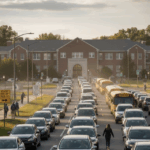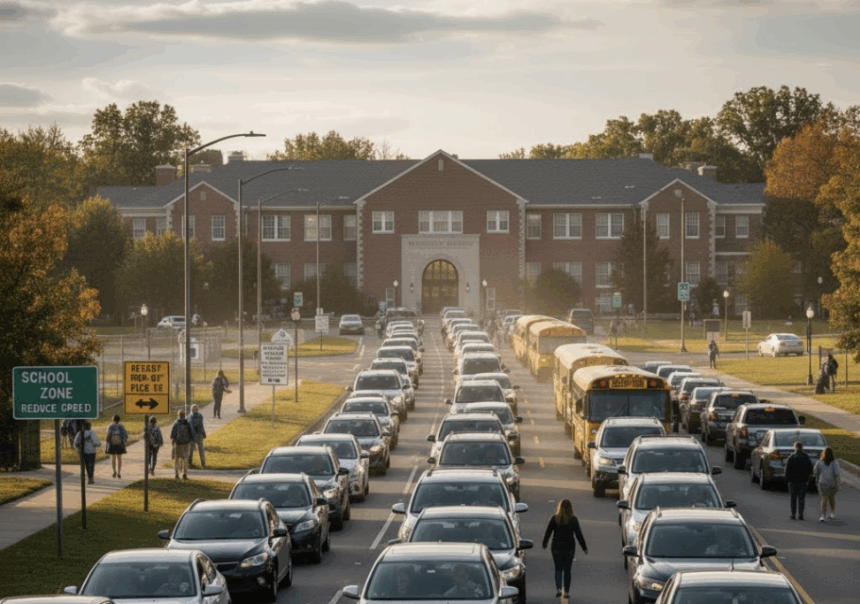Traffic congestion in Ulaanbaatar today has become one of the capital’s most critical issues. During morning and evening peak hours, tens of thousands of vehicles slow down on the main roads, wasting everybody’s time, increasing air pollution, and reducing economic productivity. In some sections, the speed of traffic barely reaches 10 km/h.
One of the biggest causes of congestion is the movement of schoolchildren. Research has shown that 56 percent of morning and evening congestion is related to parents dropping off and picking up their children from school. This is because most schools in the capital, especially state and private schools that offer quality education, are in the central districts. This forces many families living in the ger districts (outskirts) to commute to the city center by car every day. The concentration of schools, organizations, and services, along with poor public transport planning, has made the city center constantly gridlocked. Since public transport is overcrowded and frequently delayed, many households have no choice but to use their own cars.
The city proposed a method: Odd-Even License Plate Restriction
The capital city administration has proposed restricting vehicle license plates by odd and even numbers to reduce congestion. The decision is that vehicles with even numbers can participate in traffic on even-numbered days, and odd numbers on odd-numbered days. It is estimated that this will reduce the number of vehicles on the road by 30–40 percent.
However, citizens are receiving this policy with criticism. Many consider it unfair and difficult to implement in daily life. Some are demanding tax relief in exchange for the restriction of their right to use a vehicle they legally purchased and for which they fully paid taxes. Furthermore, international experience shows that such measures have not yielded sustainable results in the long term. Examples from cities like Jakarta, Manila, and Mexico City show that residents bought a second, cheap car with the opposite license plate type, increasing air pollution and the number of accidents. Therefore, without public transport and urban planning reforms, the odd-even method is an attempt to treat only the external symptom of congestion, not its root cause.
Fairer and Smarter Solutions
Instead of temporary measures, long-term, comprehensive solutions are needed that respect citizens’ rights and ensure sustainability.
(1) Decentralize Education and Service Concentration The policy of establishing new schools and kindergartens in the expanding ger districts and city outskirts needs to be intensified. If the quality of education and services were geographically equitable and accessible, the flow of cars toward the center would drastically decrease. This would incentivize people to organize their work and life closer to home.
(2) Improve the Quality of Public Transport
The capital must focus on developing reliable and modern public transport. Implementing electric buses and dedicated lanes for Bus Rapid Transit (BRT) is particularly effective. A regular timetable, electronic payment system, and priority lanes will encourage many people to leave their cars and choose public transport.
(3) Promote Carpooling Culture
Another realistic and fair solution is to create a culture of sharing cars among families, schools, and work colleagues. Currently, an average of only one passenger per car contributes to increasing congestion. Schools and organizations could establish carpooling groups and systems internally, and city authorities could partner with the private sector to introduce a “Smart Sharing” application. This would reduce fuel consumption, air pollution, and congestion without restricting the citizens’ right to mobility.
(4) Smart Traffic Management and Technological Solutions
Digital solutions such as coordinated traffic light systems, traffic flow monitoring cameras, and real-time data-based parking management will enable more optimized congestion management.
(5) Introduce Higher Tariffs or “Entry Fee” in the City Center
In many cities worldwide, one of the most effective methods to reduce congestion is a policy of imposing an additional fee, or “congestion charge,” for driving into the central zone. Cities like London, Singapore, and Stockholm have successfully reduced central road traffic by 20–30 percent and increased public transport revenue with this policy. This principle can also be implemented in Ulaanbaatar in a sophisticated and fair manner. Specifically, a system that charges a small fee for entering the most congested central districts (such as Chingeltei, central Sukhbaatar, and Bayanzurkh’s 1st-3rd khoroos) could be phased in. This revenue should be dedicated to improving public transport, road repair, and smart control systems. This will make citizens calculate the real cost of driving and become more interested in public transport. Furthermore, it is appropriate to offer exemptions or discounts to residents and citizens with disabilities. Such a pricing policy is a fairer, incentive-based approach than the odd-even restriction, and it has the effect of gradually changing traffic culture.
Conclusion
Ulaanbaatar’s congestion is not just a technical issue; it is a matter of planning, fairness, and policy coordination. While the odd-even restriction may yield temporary results, it will create new inequalities if the underlying causes are not addressed. The smart solution to congestion is urban planning reform, quality public transport, carpooling systems, and smart management technology. Only such policies can pave the way for Ulaanbaatar to become a mobile, healthy, and fair city.







